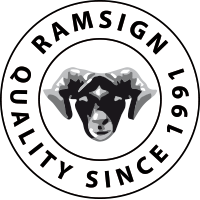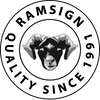Everywhere we look, signage surrounds us. From massive billboard signs to the tiny little ‘S’ and ‘P’ salt and pepper icons - signage dominates our lives. Used as a warning or as a welcome, signage is a quick and easy way to communicate.

A brief history of sign shops
Signage dates back to the times of the Greeks and Romans. They used terracotta as a signage material to attract passers into their shops or taverns with custom signs. Later in 14th Century England, King Richard III passed a law stating that any premise selling ale must display a sign outside. Since then, the signage industry has boomed into a $50 billion a year sector. But, since it is such a big industry, the amount of choice available could be overwhelming to some. If ready-made signs leave you feeling a bit uninspired, create your own to make your home stand out. At RAMSIGN we offer you guidance to help you create the perfect sign for your space.

1
Knowing When to Choose Custom Neon Signs or Traditional Alternatives
Neon name signs have become hugely popular over the last few years. But, if the glow of neon doesn’t fit your interior design style, there are many more traditional styles to play with. From rustic wooden signs to sleek enamel signs, choose your sign material to best fit your property. If the thought of being creative fills you with dread, read on to discover our top 5 design tips.
2
Designing Custom Signs and Business Signs - Don’t Forget the Who, What, Why and Where
House signs such as personalised garden signs or house numbers are simple to design since they tend to be viewed up close. The size of the sign varies depending on the distance from the viewer. The closer the viewer, the smaller the sign. This is why house numbers tend to be small. However, professional signs have many uses. From encouraging more footfall to announcing a promotion, business signs have many forms. Businesses such as hotels incorporate directional signs into their decor making it easy for people to find their way. And, of course, warning signs are an important design element for public places since they make visitors feel safe.

THE 5 W’S EXPLAINED
At RAMSIGN, it is important to define the who, what, why, when and where, before you start getting creative with your custom signs.
WHO - Who is your target market for the sign? Your family, passers-by, prospective customers, existing customers?
WHAT - What is the sign doing? Is it directing people, inspiring people, educating people, enticing people?
WHY - Why are you making this sign? Do you want to create a more welcoming entranceway? Remind people of happy memories when inside your home? Or do people need an extra helping hand in reaching your business?
WHEN - When do people see your sign? Are they driving past at a speed? Or are they seeing it from close up, at a desk, on the wall by the doorbell or on the back of an interior door? Is this a sign that goes in a special order or sequence? What is the journey of the onlooker before they reach the sign?
WHERE - Where will the sign be placed? Inside or outside? On a desk, on a door, wall or hanging from the ceiling?
Deciding on these key factors will give a clear idea of the function of your sign and the design needed.

3
Design a Sign: Keep It Visible and Readable
Visibility is the most crucial aspect of signage. There is no point in designing beautiful custom signs if no one can see them. Signage is meant to be seen and displayed with pride. It is important to consider the size of the sign, the amount of white space used and the typefaces that you have chosen for your message.

CHOOSING THE CORRECT SIZE
When deciding upon the size of the sign that you are designing, the key factor is the distance from the viewer. Will the sign be seen from the street? On a mailbox or inside a home? If an onlooker views a sign from the street, it is important to make the sign large enough to be noticed. Yet, a large size is not necessary if the sign will only be seen up close or inside a building. For example, a pub sign needs to be seen from a greater distance than a house number and therefore is larger.

CRAFTING YOUR MESSAGE
The font on your personalised metal signs must always be large enough to read. Defined lettering and fonts with enough weight also help readability. Contrary to popular belief, using ALL CAPS makes the text harder to read than capitalising the first letter. The uniform appearance of ALL CAPS stops the eye from differentiating each letter. Choosing a minimal font that works for letters and numbers is an essential step of the design process for custom signs.
Another rule of thumb to follow is to ensure that the sign does not contain too much or too little text. At RAMSIGN, we set character limits on certain signs to ensure that the design remains legible and clear. Too little text results in lots of space, while too much text makes it hard to depict what is being said. Experiment with font sizes to ensure that your message always remains readable.

AVOID CLUTTER
Everyone has heard of the phrase 'Less is More’. And this is certainly true for custom signs. A successful sign is also a simple sign. A clear and concise message is more pleasing to the eye and is quicker for the viewer to read. Let your design breathe by adding white space. Text is an essential element in personalised door signs and balancing it with the correct level of white space will enhance the design further.
We recommend that 30-40% of the sign’s surface area should be white space. Declutter your design for optimum readability and show only the essential information. Also, consider the location of the sign. Placing it in a crowded place decreases readability. Ensure that the wall is free from distractions such as cables and light switches to make the sign stand out.
4
Typefaces for Personalised House Signs
RAMSIGN’s Nordic aesthetic is based heavily on the principles of Scandinavian design. Everything from the colour schemes to the typefaces is inspired by authentic Danish design. Our range of handcrafted typefaces has been specifically designed to be used on signage, ensuring that your design remains clear, crisp and easy to read no matter how big or small the name sign may be. A lawyer may be drawn towards clean, crisp fonts that show a sense of authority. While a new homeowner may desire a cursive, soft font that gives off a welcoming, friendly feeling.

HOW TO USE TYPEFACES FOR RAMSIGN SIGNS?
The right typeface doesn’t just evoke emotions for the viewer, it also makes the sign easy to read. RAMSIGN custom signs provide the user with a live preview of their design as they are creating it. Enter in your desired text, select a typeface and see a preview of what the sign will look like. For a 100% bespoke design service, special orders allow custom fonts, colours and icons to be used in the design. Try it out, we are happy to help with any design queries.

5
Make Your Name Signs Iconic
Bring your custom signs to life through the use of a wide range of elements such as icons. The RAMSIGN Engelhardt collection encompasses the aesthetic identity of Denmark's prolific industrial designer - Knud V. Engelhardt. The iconic small red heart used to dot the ‘i’ forms a key element in this honorary collection. This unexpected motif invites the viewer to look at the sign for a few seconds longer and appreciate the design. Icons can be added to signs via the 'Advanced Customisation' page. Choose which icon you want to add to your name plaques, give us directions on how you want it placed and we will send you a proof ready for review before production begins.
SIGNS FOR ALL THE FAMILY - ADD AN ICON!
Perhaps you want to make your furry friend feel at home with a sign dedicated to them, in which case a symbol of a dog, cat, paw print or bone would be a nice choice. Alternatively, if your personalised plaques are going to be used to help people find their way around your premises, then our range of hand-drawn arrows will give a stylish touch to your space. Regardless of the purpose of your sign, a carefully placed icon will bring custom signs to life and spark the interest of passers-by.

THE BEAUTY OF ENAMEL SIGNS
Enamel is one of the most durable materials for signage. It is hard-wearing, resistant to extreme weather conditions and also graffiti-proof. It has been used for signage for centuries. And, it was once the material of choice for advertising and street signs. The mass production of enamel signage has now converted into an artisan production. Layers of glossy enamel cover steel plates and the chosen message is hand stencilled onto the sign to create a light relief. This combination of textures adds a luxurious finish to the design. And, if cared for correctly, enamel signs can last for decades, if not centuries.
ADD PERSONALITY TO METAL SIGNS
While technicalities are important, personality is the crucial element when it comes to signage design. Personality brings life to the design and makes it interesting. This is especially important for businesses that rely on personality and branding to build trust and relationships with their customers. Custom signs that don’t fit the branding will give an unprofessional and unsatisfactory image of the business.


